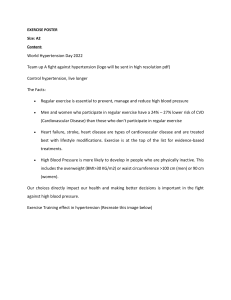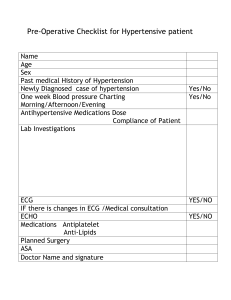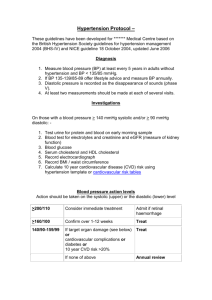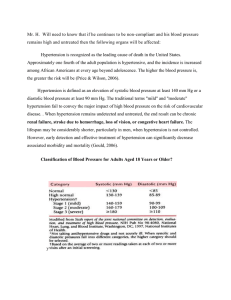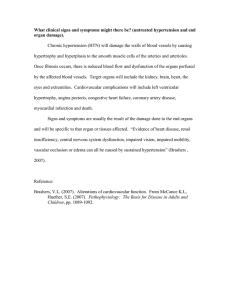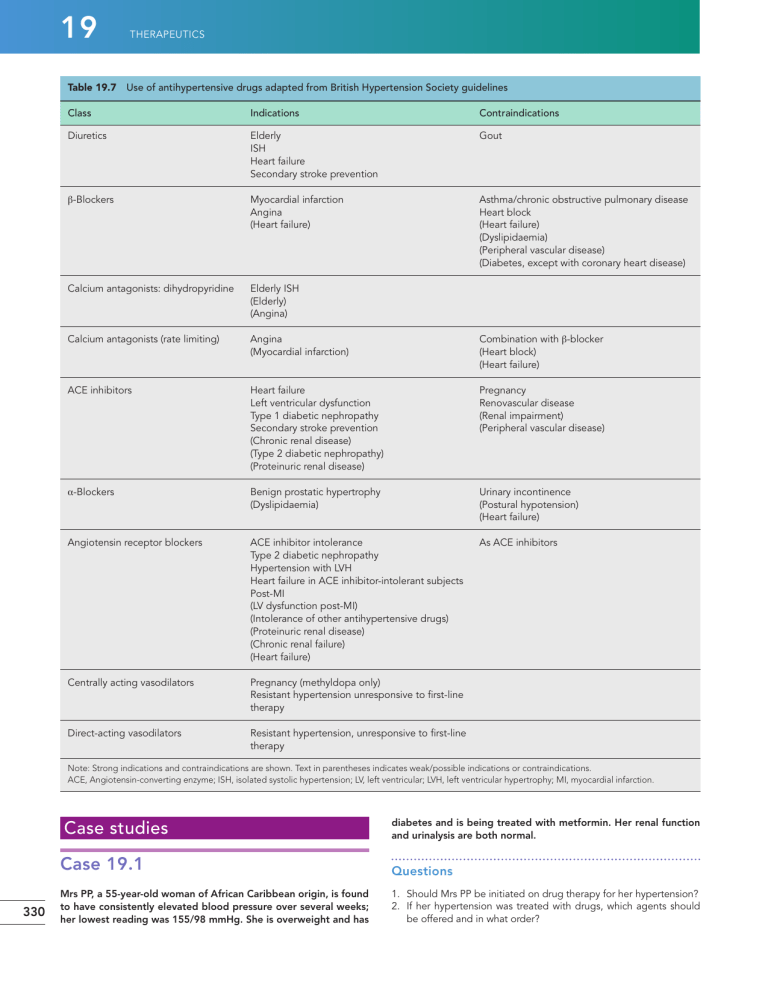
19 THERAPEUTICS Table 19.7 Use of antihypertensive drugs adapted from British Hypertension Society guidelines Class Indications Contraindications Diuretics Elderly ISH Heart failure Secondary stroke prevention Gout β-Blockers Myocardial infarction Angina (Heart failure) Asthma/chronic obstructive pulmonary disease Heart block (Heart failure) (Dyslipidaemia) (Peripheral vascular disease) (Diabetes, except with coronary heart disease) Calcium antagonists: dihydropyridine Elderly ISH (Elderly) (Angina) Calcium antagonists (rate limiting) Angina (Myocardial infarction) Combination with β-blocker (Heart block) (Heart failure) ACE inhibitors Heart failure Left ventricular dysfunction Type 1 diabetic nephropathy Secondary stroke prevention (Chronic renal disease) (Type 2 diabetic nephropathy) (Proteinuric renal disease) Pregnancy Renovascular disease (Renal impairment) (Peripheral vascular disease) α-Blockers Benign prostatic hypertrophy (Dyslipidaemia) Urinary incontinence (Postural hypotension) (Heart failure) Angiotensin receptor blockers ACE inhibitor intolerance Type 2 diabetic nephropathy Hypertension with LVH Heart failure in ACE inhibitor-intolerant subjects Post-MI (LV dysfunction post-MI) (Intolerance of other antihypertensive drugs) (Proteinuric renal disease) (Chronic renal failure) (Heart failure) As ACE inhibitors Centrally acting vasodilators Pregnancy (methyldopa only) Resistant hypertension unresponsive to first-line therapy Direct-acting vasodilators Resistant hypertension, unresponsive to first-line therapy Note: Strong indications and contraindications are shown. Text in parentheses indicates weak/possible indications or contraindications. ACE, Angiotensin-converting enzyme; ISH, isolated systolic hypertension; LV, left ventricular; LVH, left ventricular hypertrophy; MI, myocardial infarction. Case studies 330 diabetes and is being treated with metformin. Her renal function and urinalysis are both normal. Case 19.1 Questions Mrs PP, a 55-year-old woman of African Caribbean origin, is found to have consistently elevated blood pressure over several weeks; her lowest reading was 155/98 mmHg. She is overweight and has 1. Should Mrs PP be initiated on drug therapy for her hypertension? 2. If her hypertension was treated with drugs, which agents should be offered and in what order? HYPERTENSION Answers 1. Provided Mrs PP’s blood pressure has been measured accurately over several weeks, it demonstrates stage 1 hypertension. It is important to ensure that an appropriately sized blood pressure cuff is being used, in view of her obesity. She should be treated with both lifestyle advice and drug therapy because she also has diabetes. Restriction of salt intake may be particularly helpful in people of black African or Caribbean family origin, and weight reduction would benefit her hypertension and diabetes. 2. NICE (2015b) guidance recommends that first-line antihypertensive drug treatment for a person of African or Caribbean family origin should be an ACE inhibitor plus either a diuretic or a calcium channel blocker. This conflicts with the recommendation in the 2011 NICE guideline, which suggests that ARBs are preferred to ACE inhibitors in people of black African or Caribbean family origin, but the recommendation is based on the greater wealth of clinical trial data to support ACE inhibitors in people with diabetes. Calcium channel blockers do not have adverse metabolic effects and are effective in people of this origin and would, therefore, be an appropriate choice. If blood pressure remains uncontrolled, the addition of either diuretic or CCB should be considered (whichever was not initiated at step 1). Tight blood pressure control is important, and if blood pressure is not controlled with three agents, an α-blocker, β-blocker or potassium-sparing diuretic could be considered for addition at this stage. Case 19.2 Mr PT, a 35-year-old man, is overweight and has a blood pressure of 178/108 mmHg. He smokes 25 cigarettes daily and drinks 28 units of alcohol per week. He has a sedentary occupation. He eats excessive quantities of saturated fat and salt. Mr PT subsequently stopped smoking and lost some weight but remained hypertensive. He was treated with atenolol 50 mg daily. His blood pressure fell to 136/84 mmHg, but he developed tiredness and bradycardia and complained of erectile impotence. 19 a calcium channel blocker or diuretic. Other drugs could be added or substituted if Mr PT was intolerant to initial therapy or it did not reduce his blood pressure to target levels; with calcium channel blocker recommended at step 2 and the addition of a thiazide type diuretic at step 3 (although these can also cause impotence). Case 19.3 A 24-year-old woman, Ms SR, with a family history of hypertension is prescribed an oral contraceptive. Six months after starting this, she is noted to have a blood pressure of 148/96 mmHg. Question How should Ms SR be managed? Answer If Ms SR’s blood pressure is consistently raised, she may have either essential hypertension or hypertension induced by the oral contraceptive (secondary hypertension) or a combination. Her blood pressure may fall if her oral contraceptive is discontinued. Ms SR will, however, need advice on adequate contraceptive methods. A progesterone-only preparation would be one possibility. She would need careful counselling about the methods available and how successful they are. If her blood pressure remained elevated after discontinuing her oral contraception, she is likely to have underlying hypertension. This may be essential in nature, in view of the family history; however, because of her age, Ms SR should undergo some investigations to exclude possible secondary causes of hypertension. She is at low risk of complications, and there is no urgency to consider drug treatment. If there is a strong wish to use combined oral contraception, it would be important to control other risk factors as far as possible and to consider drug treatment for her hypertension. Case 19.4 Questions 1. How should Mr PT be managed? 2. What are the treatment options for Mr PT? Answers 1. Since Mr PT is a young man, his absolute risk of cardiovascular events is likely to be low, at least for the time being; however, this should be confirmed using QRisk. His total cholesterol and high-density lipoprotein (HDL) cholesterol levels, as well as height and weight, will be needed to accurately access his risk. Mr PT has several cardiovascular risk factors that need to be addressed, including his sedentary lifestyle and his smoking. Non-pharmacological methods have the potential of reducing his blood pressure considerably, including dietary modification, weight loss, and reduced salt intake. He is unlikely to qualify for lipid-lowering therapy at this point because of his young age and presumed low cardiovascular risk. Because he has stage 2 hypertension, drug treatment should be initiated in parallel with lifestyle advice. 2. β-Blockers are no longer recommended for the first-line treatment of hypertension, and Mr PT is complaining of significant adverse effects, which may affect adherence. In line with guidance and to address his adverse effects, he should be changed to a drug of a different class such as an ACE inhibitor, in view of his age (NICE, 2011). This is likely to be more effective for blood pressure lowering than Mrs GJ, a 73-year-old woman, has a long-standing history of hypertension and intolerance to antihypertensive drugs. Bendroflumethiazide was associated with acute attacks of gout, she developed breathlessness and wheezing while taking bisoprolol, amlodipine caused flushing and headache and doxazosin was associated with intolerable postural hypotension. Four weeks earlier she had been started on enalapril but then complained of a dry, persistent cough. Her blood chemistry has remained normal. Questions 1. Is Mrs GJ’s cough likely to be an adverse effect of enalapril? 2. What other options are available for controlling her blood pressure? Answers 1. Yes, a dry cough is a common adverse effect of ACE inhibitors. It affects approximately 10–20% of recipients and is more common in women. Some patients are able to tolerate the symptom, but in many, the drug has to be discontinued. 2. Angiotensin receptor blockers can be used in patients intolerant of ACE inhibitors due to cough. They are unlikely to produce this symptom because they do not inhibit the metabolism of 331 19 THERAPEUTICS pulmonary bradykinin. Centrally acting agents such as methyldopa or moxonidine could also be considered. However, these are not well tolerated, and side effects are quite likely in this patient. A non-dihydropyridine calcium channel blocker such as diltiazem or verapamil is another alternative. Measurement of plasma uric acid could also be considered followed by prophylactic treatment with allopurinol before introducing a diuretic. Alternatively, a trial of spironolactone could be considered, although renal function will need careful monitoring. Case 19.5 Mrs KB, a 23-year-old woman, has a normal blood pressure (118/82 mmHg) when reviewed at 8 weeks of pregnancy. In the 24th week of pregnancy, she is reviewed by her midwife and found to have a blood pressure of 148/96 mmHg. Urinalysis is normal. airways disease, and this may be worsened by the atenolol. Third, there is increasing evidence to demonstrate that the combination of a thiazide and a β-blocker increases the risk of developing diabetes. The prescription should be discussed with the prescriber. The addition of an ACE inhibitor or ARB would be a suitable alternative in line with NICE (2011) guidance. Case 19.7 A patient, Mr AG, is admitted to hospital with a stroke. A CT scan of the brain shows a cerebral infarct. The patient’s blood pressure is 178/102 mmHg and remains at this level over the first 6 hours after admission to the ward. Question Should Mr AG be prescribed antihypertensive medication? Questions 1. What is the likely diagnosis? 2. What complications does Mrs KB’s high blood pressure place her at increased risk of? 3. Should she receive drug treatment? If so, with which drug, and if not, how should she be managed? Answers 1. Mrs KB may have gestation-induced hypertension or chronic hypertension that had previously been masked by the fall in blood pressure that happens in early pregnancy. 2. She is at increased risk of pre-eclampsia and intrauterine growth retardation. 3. There are differences of opinion between specialists as to whether blood pressure should be treated at this level during pregnancy. In favour of treatment is the substantial rise over the earlier blood pressure recording. Some specialists would not treat unless the blood pressure was greater than 170/110 mmHg or other complications were present, but NICE (2010) recommends intervention if the BP is greater than 150/100 mmHg. If Mrs KB was treated, methyldopa would be a suitable choice. In any event, Mrs KB requires close monitoring of her blood pressure, urinalysis and fetal growth. Case 19.6 An elderly patient, Mr GD, comes to the pharmacy with a prescription for the following medications: salbutamol inhaler 200 micrograms as required, beclometasone inhaler 200 micrograms twice daily, bendroflumethiazide 2.5 mg daily, modified release diltiazem 180 mg once daily and atenolol 50 mg daily. The atenolol was being started by Mr GD’s primary care doctor, apparently because of inadequate blood pressure control. Question What action should the pharmacist take? Answer 332 There are three reasons to be concerned about the addition of atenolol to Mr GD’s drug regimen. First, there is a potentially hazardous interaction with diltiazem, which may result in severe bradycardia or heart block. Second, Mr GD is receiving treatment for obstructive Answer There is no good evidence that antihypertensive drug treatment is beneficial in the early stages of acute stroke, and there is a risk that lowering blood pressure may compromise cerebral perfusion further. However, in the longer-term, blood pressure reduction is valuable for preventing further strokes and other cardiovascular events. It would be appropriate to monitor Mr AG’s blood pressure and start treatment after a few days if it remains persistently elevated. A thiazide diuretic and/or ACE inhibitor are commonly used under these circumstances, following the demonstration of benefit in the PROGRESS study (PROGRESS Collaborative Group, 2001). Case 19.8 Mr TH, a 67-year-old man, has been treated for hypertension with atenolol 50 mg daily for several years. He feels well, and his blood pressure is controlled. Mr TH has read an article in the paper that suggests atenolol is not considered the most suitable drug for treating high blood pressure and enquires about changing his prescription. Question Should an alteration to Mr TH’s treatment be recommended? Answer There is increasing evidence that β-blockers, including atenolol, may be less effective at preventing cardiovascular events, especially stroke, than other drugs and are associated with a higher risk of development of diabetes, especially if used in combination with thiazide diuretics. They are also less effective at reducing blood pressure in older people. However, if Mr TH’s blood pressure is well controlled and the treatment suits him, there is no strong reason to change his medication unless he is at particular risk of diabetes. Case 19.9 Mr AB, a 58-year-old man, is noted to have high blood pressure by his primary care doctor. There is no evidence of end-organ damage, and he has no other cardiovascular risk factors. The blood HYPERTENSION pressure remains greater than 160/100 mmHg each time it is checked in the surgery over several weeks, in spite of salt and alcohol reduction. Mr AB buys a wrist blood pressure monitor at a pharmacy and takes several readings at home. These are all below 130/75 mmHg. Question What advice should Mr AB be given about the need for drug treatment? 19 Answer Mr AB may have ‘white-coat’ hypertension. Because this is associated with a lower risk than sustained hypertension, he may not need drug treatment. However, before making this judgment, it is important to check that his machine is accurate. This can be done by comparing readings with a validated machine or by checking to see if the make of the blood pressure monitor has been verified as accurate by the British Hypertension Society. References ALLHAT Collaborative Research Group, 2000. Major cardiovascular events in hypertensive patients randomised to doxazosin vs. chlorthalidone. Antihypertensive and lipid lowering treatment to prevent heart attack trial (ALLHAT). J. Am. Med. Assoc. 283, 1967–1975. ALLHAT Collaborative Research Group, 2002. Major outcomes in high-risk hypertensive patients randomized to angiotensin-converting enzyme inhibitor or calcium channel blocker vs. diuretic: the antihypertensive and lipid lowering treatment to prevent heart attack trial (ALLHAT). J. Am. Med. Assoc. 288, 2981–2997. Anderson, C.S., Yining, H., Wang, J.G., et al., 2008. Intensive blood pressure reduction in acute cerebral haemorrhage trial (INTERACT): a randomised pilot trial. Lancet Neurol. 7, 391–399. Appel, L.J., Moore, T.J., Obarzanek, E., et al., 1997. A clinical trial of the effects of dietary patterns on blood pressure. N. Engl. J. Med. 336, 1117–1124. Beckett, N.S., Peters, R., Fletcher, A.E., et al., 2008. Treatment of hypertension in patients 80 years of age or older. N. Engl. J. Med. 358, 1887–1898. Beevers, G., Lip, G.Y.H., O’Brien, E., 2001. The pathophysiology of hypertension. Br. Med. J. 322, 912–916. Blood Pressure Lowering Treatment Trialists Collaboration, 2000. Effects of ACE inhibitors, calcium antagonists, and other blood pressure lowering drugs: results of prospectively designed overviews of randomized trials. Lancet 356, 1955–1964. Brown, M.J., Palmer, C.R., Castaigne, A., et al., 2000. Morbidity and mortality in patients randomised to double blind treatment with a long acting calcium channel blocker or diuretic in the international nifedipine GITS study (INSIGHT). Lancet 356, 366–372. Bundy, J.D., Li, C., Stuchlik, P., et al., 2017. Systolic blood pressure reduction and risk of cardiovascular disease and mortality A systematic review and network meta-analysis. JAMA Cardiol. https://doi.org/10.1001/ jamacardio.2017.1421. Cirillo, M., Lanti, M.P., Menotti, A., et al., 2008. Deinition of kidney dysfunction as a cardiovascular risk factor: use of urinary albumin excretion and estimated glomerular iltration rate. Arch. Int. Med. 168, 617–624. Clark, C.E., Taylor, R.S., Shine, A.C., et al., 2012. Association of a difference in systolic blood pressure between arms with vascular disease and mortality: a systematic review and meta-analysis. Lancet 379, 905–914. Collins, R., Petro, R., MacMahon, S., et al., 1990. Blood pressure, stroke and coronary heart disease. Part 2. Short-term reductions in blood pressure: overview of randomised drugs trials in their epidemiological context. Lancet 335, 827–838. Dahlöf, B., Devereux, R., Kjeldsen, S.E., et al., 2002. Cardiovascular morbidity and mortality in the Losartan for Endpoint reduction in hypertension study (LIFE): a randomised trial against atenolol. Lancet 359, 995–1003. Dahlöf, B., Sever, P.S., Poulter, N.R., ASCOT Investigators, 2005. Prevention of cardiovascular events with an antihypertensive regimen of amlodipine adding perindopril as required versus atenolol adding bendrolumethiazide as required, in the Anglo Scandinavian Cardiac Outcomes Trial – Blood Pressure Lowering Arm (ASCOT–BPLA). Lancet 366, 895–906. DiPiro, J.T., Talbert, R.L., Yee, G.C., et al., 2014. Pharmacotherapy: a Pathophysiologic Approach, ninth ed. McGraw-Hill Education, New York. Ettehad, D., Emdin, C.A., Kiran, A., et al., 2016. Blood pressure lowering for prevention of cardiovascular disease and death: a systematic review and meta-analysis. Lancet 387, 957–967. Furberg, C.D., Psaty, B.M., Meyer, J.V., 1995. Nifedipine: dose-related increase in mortality in patients with coronary heart disease. Circulation 92, 1326–1331. Gong, L., Zhang, W., Zhu, Y., et al., 1996. Shanghai trial of nifedipine in the elderly (STONE). J. Hypertens. 14, 1237–1245. Hansson, L., Lindholm, L.H., Niskanen, L., et al., 1999a. Effect of angiotensin-converting-enzyme inhibition compared with conventional therapy on cardiovascular morbidity and mortality in hypertension. The Captopril Prevention Project (CAPPP). Lancet 353, 611–616. Hansson, L., Lindholm, L.H., Ekbom, T., et al., 1999b. Randomised trial of old and new antihypertensive drugs in elderly patients: cardiovascular mortality and morbidity in the Swedish Trial in Old Patients with hypertension-2 study. Lancet 354, 1751–1756. Hansson, L., Zanchetti, A., Carruthers, S.G., for the HOT Study Group, 1998. Effects of intensive blood-pressure lowering and low-dose aspirin in patients with hypertension: principal results of the hypertension optimal treatment (HOT) randomised trial. Lancet 351, 1755–1762. Hodgkinson, J., Mant, J., Martin, U., et al., 2011. Relative effectiveness of clinic and home blood pressure monitoring compared with ambulatory blood pressure monitoring in diagnosis of hypertension: systematic review. Br. Med. J. 342, d3621. Holman, R.R., Paul, S.K., Bethel, M.A., et al., 2008. Long-term follow-up after tight control of blood pressure in type 2 diabetes. N. Engl. J. Med. 359, 1565–1576. Intercollegiate Stroke Working Party, 2016. Royal College of Physicians National Clinical Guideline for Stroke, ifth ed. Available at: https://www.strokeaudit.org/SupportFiles/Documents/Guidelines/2016-N ational-Clinical-Guideline-for-Stroke-5t-(1).aspx. JATOS Study Group, 2008. Principal results of the Japanese trial to assess optimal systolic blood pressure in elderly hypertensive patients. Hypertens. Res. 31, 2115–2127. Julius, S., Kjeldsen, S.E., Weber, M., et al., 2004. Outcomes in hypertensive patients at high cardiovascular risk treated with regimens based on valsartan or amlodipine: the VALUE randomised trial. Lancet 363, 2022–2031. Lindholm, L.H., Carlberg, B., Samuelsson, O., 2005. Should beta blockers remain irst choice in the treatment of primary hypertension? A metaanalysis. Lancet 366, 1545–1553. Lithell, H., Hansson, L., Skoog, I., SCOPE Study Group, 2003. The Study of Cognition and Prognosis in the Elderly (SCOPE): principal results of a randomised double-blind intervention trial. J. Hypertens. 21, 875–1866. Mancia, G., Fagard, R., Narkiewicz, K., et al., 2013. ESH/ESC Guidelines for the management of arterial hypertension. Eur. Heart J. 34, 2159–2219. Mason, J., Dickinson, H., Nicolson, D., et al., 2005. The diabetogenic potential of thiazide diuretics and beta-blocker combinations in the management of hypertension. J. Hypertens. 23, 1777–1781. Medicines and Healthcare Regulatory Authority, 2014. Combination use of medicines from different classes of renin-angiotensin system blocking agents: risk of hyperkalaemia, hypotension, and impaired renal function – new warnings. Available at: https://www.gov.uk/ drug-safety-update/combination-use-of-medicines-from-differentclasses-of-renin-angiotensin-system-blocking-agents-risk-of-hyperkalaemia-hypotension-and-impaired-renal-function-new-warnings. National Institute for Health and Care Excellence (NICE), 2010. CG 107: Hypertension in pregnancy: diagnosis and management. Available at: https://www.nice.org.uk/guidance/cg107. 333

